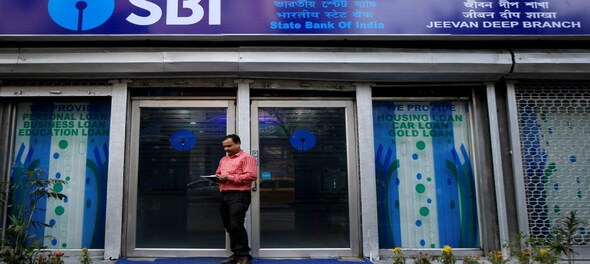
The country’s largest lender, State Bank of India, posted its highest ever quarterly net profit on the back of over Rs 11,000 crores of recovery from a single account, Essar Steel, in the December quarter. The stock ended the day higher by 2.53 percent, as investors gave a thumbs up the bank’s record profit and a lower than expected addition to bad loans.
Here are the key highlights of the bank’s third-quarter performance.
Profit
The bank reported a net profit of Rs 5,583 crores in Q3 of the current financial year, compared to Rs 3,954 crores recorded in the same quarter last year, translating into a 41.18 percent rise YoY. The bank received a cheque of over Rs 11,000 crores from Essar Steel, the resolution for which closed in the month of December, which pushed up profits significantly. This is because the bank had made a 100 percent provision against its exposure to Essar Steel and with the resolution plan being implemented, SBI was able to recover over 90 percent of the outstanding loan in this case.
What also helped was a fall in provisioning by 41 percent to Rs 8,193 crores in the third quarter compared to the same period last year.
Profit Before Tax (PBT) for Q3FY20 stood at Rs 10,970 crores, rising 65.74% YoY, and operating profit increased to Rs. 18,223 crores in the quarter from Rs. 12,625 crores in Q3FY19, an increase of 44.34 percent YoY.
Loan Growth
The bank posted a 6.79 percent growth in advances during the quarter on a yearly basis, mainly driven by a 17.49 percent growth in retail-personal advances. This is a slower pace of growth than what the bank recorded in the previous quarter when it saw a 9.5 percent raise. The street was expecting loan growth of anywhere between 8 and 10 percent, so this was a disappointment. The bank’s Chairman Rajnish Kumar, while addressing the media post the results announcement, remarked that the slowdown in corporate loan growth was the biggest discordant in the quarterly performance. Kumar said that the bank was restrained by the RBI’s “Large Economic Framework” because of which it had little headroom to increase its exposure to the top-rated corporates. That said, Rajnish Kumar told CNBC-TV18 that he would be happy if loan growth for the current financial year touch 10 percent by March 2020 in the current environment.
Asset Quality
The bank reported Gross Non-Performing Assets of Rs 1,59,661.19 crore as against Rs 1,61,636 crore in the previous quarter. The Gross NPA ratio declined to 6.94 percent in the quarter compared to 7.19 percent in Q2, and the net NPA ratio came in at 2.65 percent versus 2.79 percent in Q2.
Fresh slippages or the fresh additions to bad loan during the quarter stood at Rs 16,525 crores, and the Gross Slippages came in at Rs 20,098 crores. The bank said that one large Housing Finance Company, Dewan Housing Finance Limited, alone contributed over Rs 7,000 crores to the slippages during the quarter. In addition, the bank had also previously disclosed that it would have to recognize an additional Rs 3,143 crores as bad loan in Q3 on account of RBI’s divergence report. Both of these were factored in by the street in its estimate for the bank’s asset quality and therefore did not come as a surprise.
Among fresh additions to bad loans during the quarter, the bank disclosed that Rs 9,467 crores slipped from the corporate book, which included Rs 7,000 cr from DHFL. Further, Rs 2,965 crores of the slippages came from the agriculture sector, Rs 1,578 crores from the Small & Medium Enterprises, and Rs 821 from personal loans, including housing.
The Special Mention Account Book (SMA) fell from Rs 18,313 crores in Q2 to Rs 8,101 crores in Q3.
Asset Quality Guidance
As for the outlook, Kumar told CNBC-TV18 that the bank expects additional slippages of a maximum of Rs 6,000 crores in the March quarter, as there were no large accounts that are likely to slip in the near future. He further said that the slippages would be in the range of Rs 30,000-35,000 crores in FY21, which could include about Rs 10,000 crores of slippages from the corporate book and the remaining from the retail book. Agriculture sector book, which has been a trouble spot for the bank, could also see improvement starting the March quarter, Rajnish Kumar clarified, as the Reserve Bank of India is expected to come out with guidelines of classification of such accounts which would help align the current mismatch in the current recognition cycle with the sowing season.
Margins
SBI posted margins of 3.05 percent in Q3, the highest in 14 quarters. The recovery from Essar Steel added 22 basis points to the NIM, Chairman Rajnish Kumar told CNBC-TV18.
Recovery
The bank posted recoveries and upgrades of Rs 13,553 crores for the third quarter, compared with Rs 3,931 crores in the previous quarter, largely helped by Essar Steel. However, going ahead, the bank expects to recover approximately Rs 7,000 crores from large accounts including from Bhushan Power, Alok Industries and others by the end of March 2020.
First Published: Jan 31, 2020 8:41 PM IST
Check out our in-depth Market Coverage, Business News & get real-time Stock Market Updates on CNBC-TV18. Also, Watch our channels CNBC-TV18, CNBC Awaaz and CNBC Bajar Live on-the-go!


PM Modi, Rahul Gandhi election rallies in Delhi today: Here are the routes to avoid
May 18, 2024 11:28 AM
Celebrity Kangana vs 'royal' Vikramaditya on Himachal's Mandi seat: Clash of richest titans
May 18, 2024 11:11 AM
2024 Lok Sabha Elections | Will Amethi and Rae Bareli see the rise of Priyanka Gandhi as a dominant political figure
May 18, 2024 8:59 AM
Lok Sabha Election 2024: I.N.D.I.A. bloc to hold rally at Mumbai's BKC today
May 17, 2024 5:18 PM

